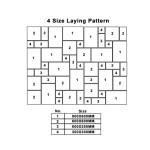How To Make A Patio On Grass: A Step-by-Step Guide
Creating a patio on grass offers a cost-effective and relatively straightforward way to enhance outdoor living space. This approach, while requiring some physical effort, eliminates the need for extensive concrete work and can significantly transform a backyard. This article provides a detailed guide on how to successfully construct a patio directly on grass, ensuring a stable, aesthetically pleasing, and durable outdoor area.
Planning and Preparation: The Key to Success
Prior to commencing any physical labor, meticulous planning is crucial. This involves assessing the site, determining the patio size and shape, selecting appropriate materials, and obtaining necessary tools. A poorly planned patio can lead to instability, drainage issues, and an overall unsatisfactory result.
Site Assessment: The first step is to thoroughly evaluate the designated area. Consider the existing grade (slope) of the land. A level surface is ideal, but a slight slope can aid in drainage. Identify any potential obstacles such as trees, large roots, or underground utilities. If utilities are present, contact the local utility company to determine their exact location and avoid any accidental damage during excavation. Also, consider the proximity of the house and any existing features like fences or gardens, ensuring the patio integrates seamlessly with the surrounding environment.
Patio Size and Shape: The size and shape of the patio should be determined based on its intended use and the overall aesthetics of the backyard. A small, square patio might be suitable for a bistro set, while a larger, rectangular patio can accommodate outdoor dining and lounging furniture. Consider traffic flow and ensure ample space for movement around the patio. Mark out the desired dimensions using stakes and string to visualize the final product. This allows for adjustments before any actual digging begins.
Material Selection: The choice of patio materials significantly impacts the patio's appearance, durability, and cost. Common options include paving stones, brick, gravel, and stepping stones. Paving stones and brick offer a more formal and durable surface, while gravel provides a more rustic and permeable option. Stepping stones are suitable for creating a pathway-like patio. When selecting paving stones or brick, consider the thickness, color, and texture. Thicker materials are generally more durable. For gravel, choose a size and type that will compact well and provide a stable surface. Consider the climate and typical weather conditions in your area when making this decision. Frost heave can damage certain materials in colder climates.
Tool and Material Acquisition: A well-equipped toolkit is essential for efficient and safe patio construction. Essential tools include a shovel, a rake, a tamper (hand or plate compactor), a level, a measuring tape, a wheelbarrow, a utility knife, and safety glasses. Depending on the chosen materials, a circular saw or brick hammer may also be necessary. In addition to the patio material itself, you will need landscaping fabric (weed barrier), bedding material (sand or crushed stone), and possibly edging material to contain the patio and prevent erosion. Acquire all necessary materials and tools before starting the excavation process to avoid delays.
Excavation and Base Preparation: Establishing a Solid Foundation
Proper excavation and base preparation are critical for ensuring the stability and longevity of the patio. This involves removing the grass and topsoil, creating a level base, and compacting the soil to prevent settling and shifting.
Grass and Topsoil Removal: Using a shovel, carefully remove the grass and topsoil within the marked boundaries of the patio. Dig down approximately 4-6 inches, depending on the thickness of the chosen patio material and the desired depth of the base layer. Ensure the edges are straight and clean. The removed topsoil can be used to fill in other areas of the yard or in garden beds. It is crucial to remove all organic matter to prevent decomposition and settling under the patio. This step is the most labor-intensive, but it is essential for a stable base.
Leveling and Grading: After removing the topsoil, use a rake to level the exposed soil. A slight slope (approximately 1-2%) away from the house is recommended to facilitate drainage. Use a level to check for any high or low spots and adjust accordingly. Proper grading is essential to prevent water from pooling on the patio surface, which can lead to damage and safety hazards. Take the time to ensure a consistent and even slope across the entire area.
Base Layer Installation: A base layer of compacted gravel or crushed stone provides a stable and well-draining foundation for the patio. Spread a layer of gravel or crushed stone (approximately 2-4 inches thick) evenly across the excavated area. Use a rake to distribute the material and ensure a consistent depth. This layer acts as a buffer between the soil and the patio material, preventing soil erosion and promoting drainage. The type of gravel or crushed stone should be chosen based on its ability to compact and its drainage properties. Typically, a crushed stone with a mixture of sizes is ideal.
Compaction: Compacting the base layer is crucial for preventing settling and maintaining the patio's stability. Use a hand tamper or plate compactor to thoroughly compact the gravel or crushed stone. Compact the layer in multiple passes, ensuring uniform compaction across the entire area. This step is often overlooked, but it is essential for a long-lasting patio. Inadequate compaction can lead to uneven surfaces and shifting patio stones over time.
Weed Barrier Installation: Lay landscaping fabric (weed barrier) over the compacted base layer. This fabric prevents weeds from growing up through the patio, keeping it looking clean and well-maintained. Overlap the edges of the fabric by at least 6 inches and secure them with landscaping staples. Trim any excess fabric along the edges of the patio. This barrier also helps to separate the base layer from the bedding layer, preventing soil from mixing with the gravel or sand.
Patio Material Installation and Finishing Touches
Once the base is properly prepared, the patio material can be installed. This involves laying the chosen materials according to the desired pattern and ensuring a level and aesthetically pleasing finish.
Bedding Layer Installation: Spread a layer of sand or bedding material (approximately 1-2 inches thick) over the weed barrier. This layer provides a smooth and level surface for laying the patio material. Use a rake to evenly distribute the sand or bedding material and ensure a consistent depth. Avoid using too much sand, as this can lead to instability. The bedding layer should be compacted lightly before laying the patio material.
Patio Material Placement: Begin laying the patio material according to the chosen pattern. Ensure each piece is level and properly aligned. Use a rubber mallet to gently tap the pieces into place. Maintain consistent joint spacing between the pieces. If using paving stones or brick, consider using spacers to ensure uniform spacing. Check the level of the patio surface frequently during installation to ensure a consistent and even surface.
Cutting and Fitting: Inevitably, some pieces of patio material will need to be cut to fit around edges or obstacles. Use a circular saw with a masonry blade or a brick hammer to cut the pieces to the desired size and shape. Wear safety glasses to protect your eyes from debris during cutting. Take accurate measurements and cut carefully to ensure a clean and precise fit. A proper fit is crucial for a professional-looking finish.
Edge Restraint Installation (Optional): Install an edge restraint to contain the patio and prevent erosion. Edge restraints can be made of plastic, metal, or wood. Secure the edge restraint along the perimeter of the patio using stakes or screws. The edge restraint should be flush with the patio surface. This step is particularly important for patios made of loose materials like gravel or stepping stones.
Joint Filling: Fill the joints between the patio material with sand or polymeric sand. Polymeric sand is a specialized type of sand that hardens when wet, providing a more stable and durable joint. Sweep the sand or polymeric sand into the joints using a broom. Compact the sand or polymeric sand into the joints using a plate compactor or hand tamper. If using polymeric sand, follow the manufacturer's instructions for activating the hardening process.
Cleaning and Finishing: Once the joints are filled, clean the patio surface with a broom or hose. Remove any excess sand or polymeric sand. Inspect the patio for any imperfections and make any necessary adjustments. The finished patio should be level, stable, and aesthetically pleasing. Allow the patio to cure or settle for a few days before placing furniture or heavy objects on it.

Diy Patio With Grass Between Pavers And A Fire Pit

Diy Patio With Grass Between Pavers And A Fire Pit

Diy Patio With Grass Between Pavers And A Fire Pit

Diy Patio With Grass Between Pavers And A Fire Pit

Diy Patio With Grass Between Pavers And A Fire Pit

40 Remarkable Backyard Grass Ideas Large Landscaping Patio No

Diy Patio With Grass Between Pavers And A Fire Pit

How To Lay Decking On Soil Or Grass Ronseal

How To Build A Diy Patio For Less Than 300 The Rose Table

Diy Crushed Pea Gravel Patio Install
Related Posts








